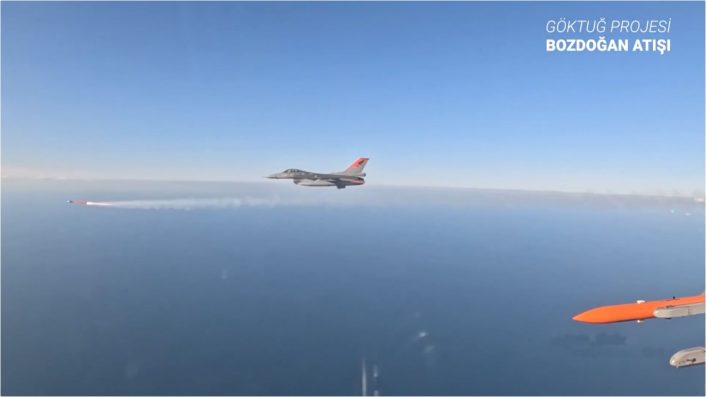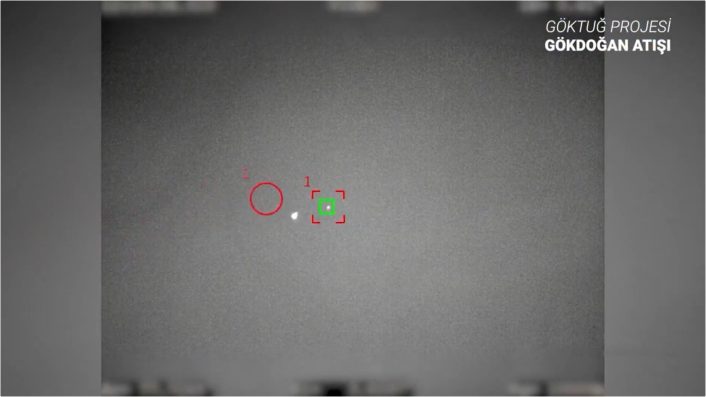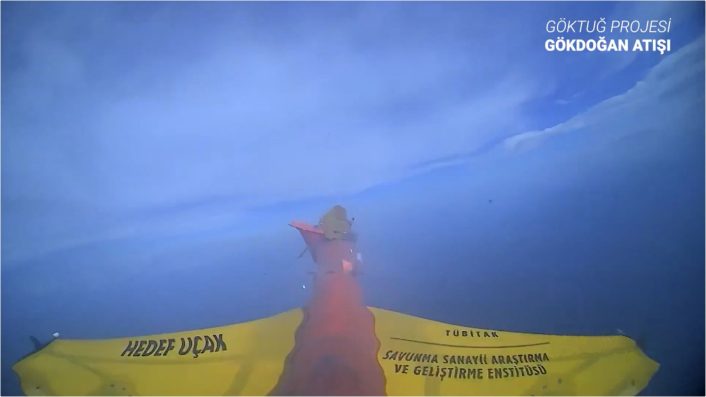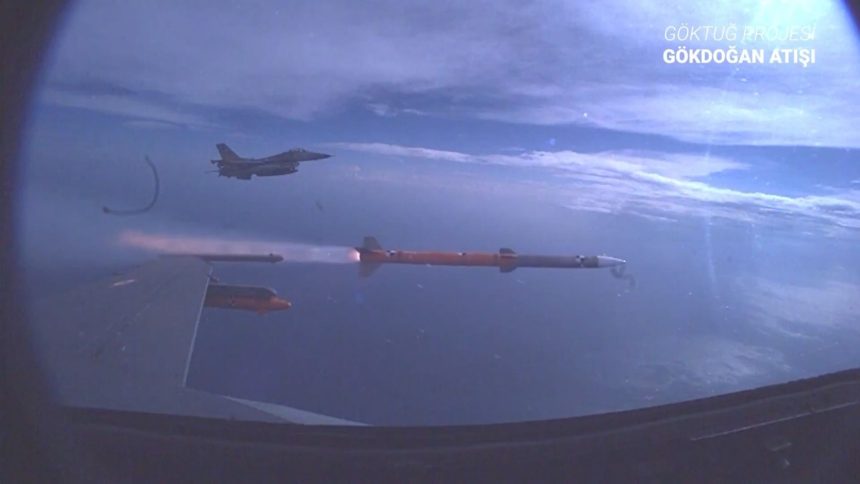Both missiles are developed by TÜBİTAK-SAGE, and would arm Turkey’s F-16 and Kaan fighters, the Kizilelma UCAV, and even the JF-17 Thunder Block 3 fighter used by Pakistan and Azerbaijan.
Turkey conducted live-fire tests of its Gökdoğan beyond visual-range and Bozdoğan within visual-range AAMs (Air-to-Air Missiles) from an F-16 on Oct. 19, 2025, with both the missiles hitting pilotless target drones. The missiles are long in a line of indigenous programs, including UCAVs like the Kizilelma, Anka III, the fifth-generation Kaan fighter, the Hürjet advanced jet trainer and wide-range of surface-to-air and surface-to-surface missiles.
Both missiles, developed by TÜBİTAK-SAGE, have been tested prior to this, but this appears to be the first time that they were successively launched together from a single F-16 during the same test. Minister for Industry and Technology Mehmet Fatih Kacir called the successful trial a result of the country’s “advanced engineering, unrelenting determination and ideal full of independence.”
The Bozdoğan’s first live test took place on Apr. 14, 2021, from a Turkish F-16, successfully destroying a Şimşek target drone. Gökdoğan was first live-tested in 2018, followed by another test reported by Minister of Industry and Technology Mehmet Fatih Kacır on Feb. 12, 2025.
🔵🇹🇷Yerli hava-hava füzelerinden tam isabet
🔸TÜBİTAK SAGE tarafından geliştirilen BOZDOĞAN ve GÖKDOĞAN hava-hava füzeleri, zorlu test atışlarını başarıyla tamamladı.
📎@SageTubitak
🔗https://t.co/ny3eGv4jnq pic.twitter.com/N7Iyf6YRzp
— Defence Turk (@Defence_Turk) October 20, 2025
Plans for mass production of both missiles were announced on Jun. 3, 2022, followed by a “Low-Scale Initial Production” contract signed between the Presidency of Defense Industries (SSB) and developer TÜBİTAK-SAGE on Jul. 27, 2023. Twenty-five units of each of the missiles and 14 launchers were to be delivered by 2025.
The test
The video showed a specially instrumented F-16 taxiing and taking off with two Gökdoğan and Bozdoğan test missiles, as shown by the markings and their orange color. The missiles are mounted on each of the wingtip and outer hardpoint launchers.
Another F-16 follows as a chase aircraft, and both jets are supported by a Turkish Air Force KC-135 Stratotanker. With several in-flight cameras and the chase aircraft capturing the launches, both missiles hit the pilotless target drone head on.
One of the target drones is also captured departing from a ground-based rail launcher. It is not clear if the other two missiles from the starboard (right)-side wing were also fired, as only the Gökdoğan and Bozdoğan from the port-side wing are shown being released.
IR footage also shows both the missiles striking the target. Interestingly, the Bozdoğan appears to climb up in a steep trajectory after being released, possibly conducting a ‘lofting’ maneuver.
Gök Vatanın Sarsılmaz İki Pençesi
🚀 BOZDOĞAN
🚀 GÖKDOĞAN
İleri mühendisliğimizin, bitmeyen azmimizin ve tam bağımsızlık idealimizin gökyüzüne kazınmış iki imzası… 🎯@SageTubitak tarafından geliştirilen yerli ve milli hava-hava füzelerimiz, zorlu test atışlarını başarıyla… pic.twitter.com/m8kwEgCST8
— Mehmet Fatih KACIR (@mfatihkacir) October 19, 2025
The missiles
The Bozdoğan, according to TÜBİTAK-SAGE, is a Within Visual-Range (WVR) short-range AAM with a range of over 25 km, powered by a “high-thrust reduced smoke solid propellant”. An IIR (Imaging Infrared) seeker and a thrust vector control offers high-G maneuverability and an “all-aspect” high-off boresight engagement capability.
TÜBİTAK-SAGE puts the Gökdoğan’s range of over 65 km, powered by a solid-fuel rocket engine and a solid-state active RF (Radio Frequency) seeker. A ‘lock on after launch’ mode is supported by a data-link that can receive target updates from the launching aircraft. Kacir said the missile also has “advanced control algorithms.”
Both missiles began development in 2012 as a part of the broader GÖKTUĞ project. The goal of the project is to have new domestically-developed air-to-air missiles for the Turkish F-16s that were upgraded under the local PO-III (Peace Onyx III) effort.

Even more significantly, both missiles are reported to be integrated with the Azerbaijan Air Force’s JF-17 Thunder Block 3 fighters, jointly developed by the Pakistan Aeronautical Complex (PAC) and Chengdu Aircraft Corporation (CAC). Azerbaijan signed a deal to acquire up to 40 JF-17s, although deliveries have not yet started.
Both the new missiles are compatible with the U.S. MIL-STD-1553 and MIL-STD-1760 interfaces, data bus standards and the LAU-129 launcher. However, Turkish-built mission systems would offer optimized performance and quickly identify scope for upgrades.

Renditions and official presentations have shown even longer-ranged Gökdoğan-ER (Extended Range), the Gokhan Block-1 and Block-2 air-breathing ramjet missiles, appearing to be roughly in the same class as the Meteor, and another ramjet-powered missile, the Gokbora. A Turkish account reported on Jan. 1 that the Gokhan has cleared its conceptual and preliminary design phases, and is undergoing ground testing.
Why is Turkiye demanding software rights of F16?
Turkiye is among the leading countries developing NATO and Europe’s most diverse and precision-guided munitions families. Not using the technologies developed by Turkiye in the aforementioned aircrafts we will purchase would… https://t.co/Bnpz7kJ6ng pic.twitter.com/WT0MpMad0z
— TR_tech (@T_Nblty) October 18, 2025
Turkish F-16s
The advancement with the Gökdoğan and Bozdoğan missiles can also be seen amid the broader Özgür program, of which Turkey announced last year an expansion, bringing more F-16s under the massive domestic project. The new program has also been reported as Özgür II by some sources.
This followed the decision to drop the 79 modernization kits for its F-16s, and just acquire 40 F-16 Block 70 aircraft from the U.S. According to Reuters, the Turkish Air Force (Türk Hava Kuvvetleri) operates a little over 200 F-16s in the Block 30, 40 and 50 variants, making it NATO’s second-largest fleet of F-16s.

Özgür had originally identified 35 F-16 Block 30 jets that TAI/TUSAŞ (Turkish Aerospace Industries), TÜBİTAK SAGE and Aselsan would upgrade with a host of new in-house software, avionics and electronics. The components comprised a national mission computer; system interface units; cockpit upper front control panels; fuel hydraulic indicators; engine display screens; emergency indicators; national sound safety devices; national IFF (Identification Friend-Foe) system; multi-mode receivers; inertial navigation systems; interface blinding units; helmet integrated aiming systems; center cockpit indicator; and color multifunction displays.









